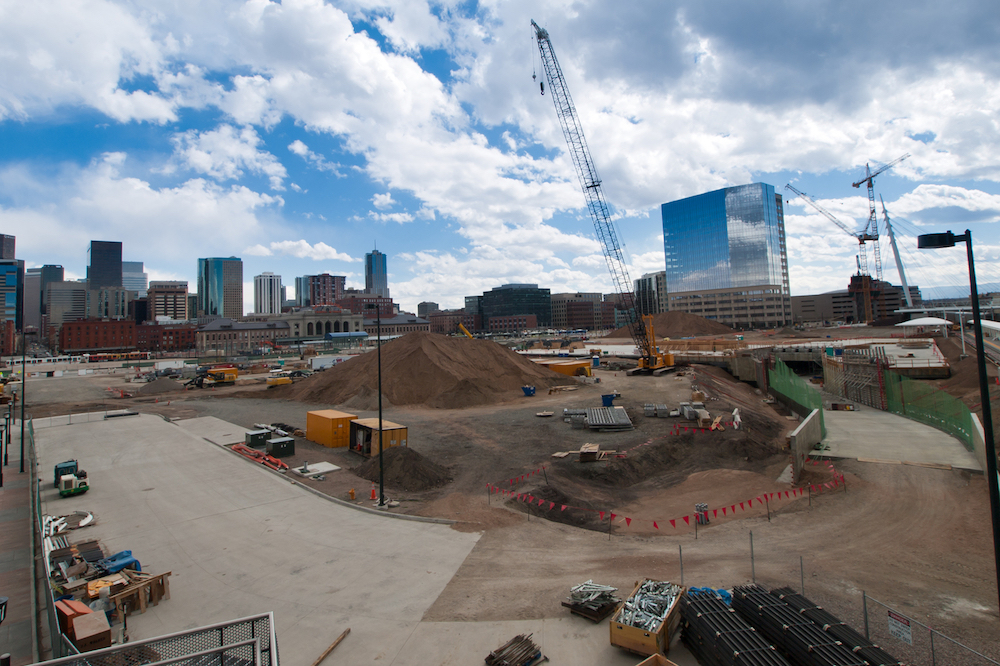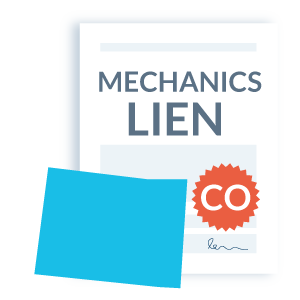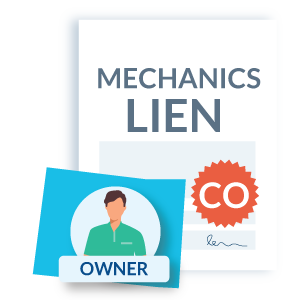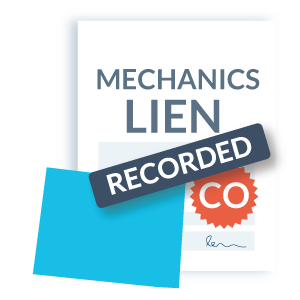
Mechanics liens are powerful tools that can get construction project participants the fair payment they deserve. If you are unpaid for labor or materials you furnished to a construction project in Colorado, filing a lien may be the answer to ensure that you get paid what you have earned. This how-to guide provides a start-to-finish explanation on how to file a Colorado mechanics lien.
To successfully record your mechanic’s lien, you need to comply with notice requirements, prepare and format documents according to state-specific detail, comply with deadlines, and record with the proper office. Colorado law is strict about the procedure to file a lien claim. There are plenty of opportunities to make a mistake, and any small mistake can potentially invalidate your entire lien claim.
Keep reading to make sure you can get all the details right, get your claim filed, and get what you’ve earned without delay.
Steps to file a Colorado mechanics lien
Lien claimants in Colorado must follow these steps to record a mechanics lien, before the deadline to file expires:
- Fill out the right Colorado mechanics lien form
Using a mechanics lien form that meets the statutory requirements, fill it out completely and accurately.
- Send a Notice of Intent to Lien to the property owner
Send a notice of intent to lien to the property owner at least 10 days before filing the lien claim. You need to include a copy of the notarized, completed lien form with the notice of intent.
- File your lien claim with the Colorado county recorder
Deliver your completed lien form to the recorder’s office in the Colorado county where the property is located, and pay the filing fee. You will also need to include an Affidavit of Service, affirming the delivery of the notice of intent.
Watch the Video: How to File a Mechanics Lien in Colorado
Before you File: Send a Notice of Intent to Lien
In Colorado, all lien claimants are required to send a notice of intent to lien at least 10 days prior to filing their lien claim.
Unlike many other states, however, Colorado requires an affidavit of properly serving the notice of intent on the property owner to be included for filing with the lien claim itself. Since the 10-days given in the notice of intent does not extend the period in which to file a lien, it is important for a potential lien claimant to make sure that the notice is served more than 10 days before the lien deadline, so that the lien can be filed (with the affidavit attached) before the time to do expires.
Furthermore, Colorado requires that you attach a fully completed and executed Lien Statement with the notice. That means you need to have your mechanics lien fully prepared and executed before sending the Notice of Intent to Lien document. You must, therefore, have already researched the legal property description, the legal property owner, and had the lien fully prepared and notarized. That’s quite a lot of work for a notice.
Preparing Your Colorado Mechanics Lien Document
Once lien rights have been preserved by serving the property owner and prime contractor with a notice of intent to lien via personal service or by registered or certified mail, return receipt requested, the first step to successfully claiming and filing your lien is to properly prepare your mechanics lien form.
While this is generally a pretty straightforward and simple task, be aware that mechanics lien laws are very exacting and even if you have the proper form, there can be pitfalls. A lien form can require information you don’t have, or be confusing with respect to how specific you need to be. This section will help you determine and obtain the mechanics lien form you need, get it filled out properly and completely, and get is ready for filing.
Getting the Mechanics Lien Form You Need
There is nothing inherently special about a mechanics lien document itself – a mechanic’s lien is simply a piece of paper containing certain information that is filed with a government office. However, it is imperative that you get the right mechanics lien form, and that you fill it out completely and with the right information. It’s a common mechanic’s lien mistake to start with a generic form, or some other incorrect form, and for the claimant to shoot him/herself in the foot before even starting. There are lots of sites claiming to provide compliant lien forms for claimants in Colorado, but not all of these form farms have the correct documents.
For example, many form repositories don’t know that Colorado is one of the few states that has a specific statement of mechanics lien form for subs and suppliers and a different form for GCs. Not using the correct Colorado mechanics lien form may mean a rejected lien from the County Recorder or an invalid lien if challenged in court.
- Download: Colorado mechanics lien form for subcontractors & suppliers
- Download: Colorado mechanics lien form for General Contractors
These forms meet the requirements set forth in at Colorado Revised Statutes, §38-22-101 through §38-22-133 as enacted by the Colorado legislature. They were created and reviewed by construction attorneys and payment experts. Thousands of Colorado contractors and suppliers like you have relied on our mechanics lien forms to get paid.
Information to Include on a Colorado Mechanics Lien Form
Now that you have the correct form, it’s time to produce the lien document. Colorado has specific requirements (set forth by Colorado Revised Statute § 38-22-109) that mandate what information must be included on a lien statement. Failing to include the required information can result in an invalid and unenforceable lien. A Colorado mechanics lien must be signed and sworn to by the party claiming the lien (or someone on their behalf), must be notarized, and must contain the following information:
1. The name of the owner or reputed owner of the property, or in case such name is not known to him, a statement to that effect.
A mechanic’s lien is filed against the property, and generally must include the name of the property owner against whose interest in the property the lien is claimed. This can be important for many reasons, not the least of which is that ownership information can be used to index the lien in the county records.
Determining the owner of the property can be difficult. If you did not contract directly with the property owner, the owner’s name may not appear on your contract documents, or otherwise be known to you. This may require some sleuthing, by checking county tax assessor sites, GIS maps, calling or visiting the county recorder, or using a service or third-party database to. Additionally, there can be circumstances that make determining the identity of the “owner” even more complex. Jobs started by a tenant may make you wonder whether to identify the property owner or the tenant (answer: identify both!). The property may have been sold during the course of the project and you might not know which owner to identify. There could be multiple owners and you’re not sure which ones to list (answer: all of them). The work could be done on a condominium (individual units or common elements) and you may not know whether to list the individual unit owner(s) or the condominium association (best practice: list all).
2. The name of the person claiming the lien; The name of the person who finished the laborers or materials or performed the labor for which the lien is claimed.
Colorado requires that a lien claimant identify themselves on the lien document. This should be easy – you know who you are. However, it’s important that you identify yourself correctly, and use the full and correct legal name of your company (or yourself) on the document. Liens have been successfully challenged due to a misidentification or typographical error in the identification of the claimant; don’t let this be you.
3. The name of the contractor when the lien is claimed by a subcontractor or by the assignee of a subcontractor, or, in case the name of such contractor is not known to a lien claimant a statement to that effect.
The lien claimant is supposed to provide the name of the GC, if the claimant is not the GC himself. Some of the same problems with knowing or finding the identity of the property owner exist with respect to the GC, as well. And, third-party databases for finding the GC on a project are harder to find and fewer in number than databases to find property owners.
However, this requirement provides on “out” for companies who do not contract with or cannot find the identity of the GC. Colorado law allows a party who doesn’t know the identity of the GC to include a statement to that effect on the lien statement.
4. A description of the property sufficient to identify same.
The description of the property on a lien claim is one of the most crucial aspects of the lien itself. Like the identity of the property owner, the description of the property itself is crucial in indexing the lien, and making sure the lien claim can be found by third-parties (like potential purchasers, or parties who may re-finance the property).
Colorado’s mechanics lien laws require “a description of the site sufficient for identification.” This does not specifically require a formal “legal property description,” but it’s a good idea to use one anyway because this makes sure that you meet the “sufficiency” requirement. However, a simple physical address could very well meet the requirements here. Colorado case law has held that a description enabling a party familiar with the locality to identify the premises against which the lien is claimed with reasonable certainty, and to the exclusion of others, to be sufficient. Cary Hdwe. Co. v. McCarty, 10 Colo. App. 200, 50 P. 744 (1897). Further, Colorado courts are reluctant to set aside a lien claim merely because the description is “loose” and neither completely full nor precise.
Despite this, however, it is explicitly held that a legal description of metes and bounds, or a description including the lots, block, and addition are sufficient for the purposes of describing the property subject to a lien claim.
If you need help researching the legal property description on a property, check out this article: Researching The Legal Property Description for your Mechanics Lien. You may also find help by downloading our Legal Property Description Cheat Sheet.
5. A statement of the amount due or owing such claimant.
The amount of the lien claim is clearly and obviously a crucial component of the lien statement itself. The “statement of the amount due or owing” to you on your mechanic’s lien claim identifies how much you are claiming against the property. But, be careful. In Colorado, merely be stating the balance due can be insufficient to satisfy this requirement in certain circumstances – most notably when a lien statement is filed by a party claiming liens as an assignee of numerous separate claims. In that case, the claims must not be presented as an aggregate amount, but by setting forth each separate indebtedness with credits thereon.
It is important for a lien claimant to be careful when setting forth the amount due. Just because you are “owed” money doesn’t mean you can include it in your lien. Late fees, costs of collection, and more are not appropriate for inclusion on the lien itself (but there may be the possibility of recovering some amounts pursuant to a foreclosure action). The only extra amount that can be allowed as part of a judgment against the real estate, the lien, is interest. Other amounts, like attorney’s fees, may be awarded by the court. We have written about the amounts properly claimed in a Colorado mechanics lien, and the problems associated with exaggerating a lien claim, here:
- Including Interest and Late Fees on a Colorado Mechanics Lien
- Colorado Court Rules on Exaggerated Lien Claim
Though every circumstance may have some differences, the general answer here is almost always the same. You have the right to file a Colorado mechanics lien for the amount equal to the value of the work or material you have furnished to the job, and you can claim on the lien that interest is also owed. Other amounts – attorney fees, contractual amounts due, etc. – may all be owed to you, and you can sue for them, but don’t put them in your lien amount. Doing so throws your entire claim at risk.
6. An affidavit of serving the notice of intent on the property owner by personal service or by registered or certified mail, return receipt requested, addressed to the last known address of such persons at least 10 days before the filing of lien statement.
Colorado is one of few states that requires a specific affidavit of proof that the notice requirement was complied with to be included with the lien itself. Failure to provide the notice of intent at least 10 days prior to the lien being filed is fatal to a subsequent mechanics lien, but in Colorado, the failure to provide an affidavit saying you complied with the notice requirements is also fatal.
It is crucial that this affidavit be provided in order to claim a valid and enforceable lien. But, this outlines some tension in the Colorado mechanics lien requirements. The lien itself allows for the “name of the owner or reputed owner of such property, or in case such name is not known to him, a statement to that effect” to be included on the document – BUT the lien also requires an affidavit that the notice of intent was personally served or sent via registered or certified mail return receipt requested to the property owner, reputed property owner, or owner’s agent. While there may be some wiggle room there since it allows service on the reputed owner or owner’s agent, it is best to determine the owner, and notify him/her accordingly.
7. Sign Your Lien and Have Your Signature Notarized
A Colorado mechanics lien must be signed and sworn to by the party claiming the lien (or someone on their behalf). Colorado law requires the mechanics lien to be notarized.
Many liens must only be verified by the lien claimant, but in Colorado, a mechanics lien requires the claimant (or some party on the claimant’s behalf) to swear to the lien statement to the best knowledge, information, and belief of the affiant.
Recording Your Colorado Mechanics Lien
Now it’s finally time to file your mechanics lien. At first blush, this may seem like the easy part, but don’t get too confident. A lot can go wrong with lien filings, such as:
- You might get the filing fees wrong;
- You can file it in the wrong government/county office;
- You can not understand the county’s turnaround time and file late;
- You can get you lien rejected and miss your lien window;
- You can show up without the right paperwork and delay the process
Deadline to file a Colorado Mechanics Lien
One of the most crucial requirements of filing a Colorado mechanics lien is to make sure it is filed on time! Colorado has strict deadlines for when liens must be filed and missing a deadline results in the invalidity and unenforceability of the lien claim. If someone is promising you payment, that’s great, but it won’t change your lien deadline.
The time you have to file a Colorado mechanics lien depends on your role in the project and the specific project type.
- For all lien claimants except laborers who don’t provide any materials to the project, Colorado law requires that a Statement of Lien must be filed by no later than 4 months after the last day labor or materials were provided to the project – punch list items and remedial work do not count to extend the time period.
- For laborers who did not provide materials to the project, the lien must be filed after the last labor was performed and within 2 months of the completion of the improvement.
- For a one or two-family home, the normal 4-month period in which a mechanics lien may be filed is shortened to 2 months if there is a bona fide purchaser of the dwelling.
Extending the Colorado lien deadline
It’s important to note, however, that Colorado has an interesting wrinkle in the lien filing deadline. The time to file a lien may be extended if a Notice of Extension of Time to File Lien is filed with the county clerk and recorded in the county where the property is located.
This extends the time in which a mechanics lien can be filed to either 4 months after the project is completed, or 6 months after filing the extension of time – whichever occurs first. This extension is likely not available on one or two family residential projects.
Finding the Colorado County Office to record your mechanics lien
Generally speaking, you need to file your Colorado mechanics lien in the county “Recorder’s Office” in the county where the property being liened is located. The mechanics lien statute puts the proper lien filing location like this: “the office of the county clerk and recorder of the county wherein the property, or the principal part thereof, to be affected by the lien is situated.” This is helpful, because many states if a property is located in more than one county, more than one filing is required. but, in Colorado, only one lien is required to be filed in the county in which the principal part of the property is located.
Counties record a lot of different documents in a lot of different offices. You need to be sure that you’re filing in the right county, and then that you’re filing in the right office! To help ease this process, we’ve compiled all of the Colorado county offices that record mechanics liens:
- Adams County Lien Filing
- Alamosa County Lien Filing (Recorder’s Site)
- Arapahoe County Lien Filing
- Archuleta County Lien Filing (Recorder’s Site)
- Baca County Lien Filing
- Bent County Lien Filing (Recorder’s Site)
- Boulder County Lien Filing
- Broomfield County Lien Filing (Recorder’s Site)
- Chafee County Lien Filing (Recorder’s Site)
- Cheyenne County Lien Filing (Recorder’s Site)
- Clear Creek County Lien Filing
- Conejos County Lien Filing (Recorder’s Site)
- Costilla County Lien Filing (Recorder’s Site)
- Crowley County Lien Filing (Recorder’s Site)
- Custer County Lien Filing (Recorder’s Site)
- Delta County Lien Filing (Recorder’s Site)
- Denver County Lien Filing
- Dolores County Lien Filing (Recorder’s Site)
- Douglas County Lien Filing
- Eagle County Lien Filing (Recorder’s Site)
- Elbert County Lien Filing (Recorder’s Site)
- El Paso County Lien Filing
- Fremont County Lien Filing
- Garfield County Lien Filing (Recorder’s Site)
- Gilpin County Lien Filing (Recorder’s Site)
- Grand County Lien Filing (Recorder’s Site)
- Gunnison County Lien Filing (Recorder’s Site)
- Hinsdale County Lien Filing (Recorder’s Site)
- Huerfano County Lien Filing (Recorder’s Site)
- Jackson County Lien Filing (Recorder’s Site)
- Jefferson County Lien Filing
- Kiowa County Lien Filing (Recorder’s Site)
- Kit Carson County Lien Filing (Recorder’s Site)
- Lake County Lien Filing (Recorder’s Site)
- La Plata County Lien Filing (Recorder’s Site)
- Larimer County Lien Filing
- Las Animas County Lien Filing (Recorder’s Site)
- Lincoln County Lien Filing (Recorder’s Site)
- Logan County Lien Filing (Recorder’s Site)
- Mesa County Lien Filing (Recorder’s Site)
- Mineral County Lien Filing (Recorder’s Site)
- Moffat County Lien Filing
- Montezuma County Lien Filing (Recorder’s Site)
- Montrose County Lien Filing (Recorder’s Site)
- Morgan County Lien Filing (Recorder’s Site)
- Otero County Lien Filing (Recorder’s Site)
- Ouray County Lien Filing (Recorder’s Site)
- Park County Lien Filing (Recorder’s Site)
- Phillips County Lien Filing (Recorder’s Site)
- Pitkin County Lien Filing (Recorder’s Site)
- Prowers County Lien Filing (Recorder’s Site)
- Pueblo County Lien Filing
- Rio Blanco County Lien Filing (Recorder’s Site)
- Rio Grande County Lien Filing (Recorder’s Site)
- Routt County Lien Filing (Recorder’s Site)
- Saguache County Lien Filing (Recorder’s Site)
- San Juan County Lien Filing (Recorder’s Site)
- San Miguel County Lien Filing (Recorder’s Site)
- Sedgwick County Lien Filing (Recorder’s Site)
- Summit County Lien Filing (Recorder’s Site)
- Teller County Lien Filing
- Washington County Lien Filing (Recorder’s Site)
- Weld County Lien Filing
- Yuma County Lien Filing (Recorder’s Site)
What to deliver to the CO county recorder
Most counties in Colorado allow for mechanics liens to be electronically recorded, if you have an account with an electronic recording system, or wish to create one. If not, the lien may be delivered to the proper county via mail or FedEx, or personally “walked in” to be recorded.
If you have chosen to e-record, the filing and processing fees will be assessed prior through the e-recording portal you have chosen prior to recordation, and only one copy of the lien is required. Be sure, however, that you make sure a copy of the affidavit of service of the notice of intent to lien is uploaded as an exhibit.
If you have decided to personally deliver the lien for recording, or if you mail/FedEx the lien to the appropriate county, the steps are a bit different.
- Send 2 Original Copies of your Lien & Affidavit of Delivery. One copy is for the recorder to keep and record. The second copy is for the recorder to return to you. Most county recorders will not make copies for you, and you’ll want and need this, so make sure to bring 2 copies.
- Bring multiple blank checks. You can calculate your filing fees beforehand, but you shouldn’t be too confident; it seems like something always comes up! Bring blank checks so you can make the check out there on the spot. The filing fee will vary by county, so the filing fees can be determined by calling the county recorder, or asking in person if you bring the lien for filing in person. Generally, the fees are set at one amount for the first page with an additional, smaller, amount for each additional page.
- You must prove the the lien was served by having an affidavit executed indicating the notice was served personally or mail served. This affidavit (and the notice of intent) must eventually be attached with the mechanics lien filed in the county’s recording office.
- Make sure the margins and paper size are correct for the county in which you are recording your lien. These can sometimes be determined through the county recorder’s website, but otherwise, it may take a phone call.
Once you have a stamped copy of the recorded lien in your possession, then you have an official recorded mechanics lien. Congratulations! You’ve just taken a major step towards getting paid on your job.
Notifying the Property Owner Of Your Lien Claim
Unlike many states, there is no specific statutory requirement to serve a Colorado mechanics lien on the property owner after recording. This, however, seems a bit incongruous with the other requirements and is definitely not the most effective way to get paid.
Providing notice of the lien’s actual filing, in addition to providing the required notice of potentially filing a lien through the notice of intent, makes the owner aware of the lien, and can prompt payment prior to the initiation of an enforcement lawsuit.
However, since the formal serving of the filed lien is not a specific requirement in Colorado, you can choose how you want to send the lien to the owner – any way you want to do it is fine.
After You File Your Colorado Mechanics Lien
After your mechanics lien is on the books, you may be wondering, what to do next?
A Colorado mechanics lien only stays effective for 6 months after the date the project was completed, or labor or materials were last furnished to the project. After this 6-month period, if the lien is not foreclosed upon it will become void and unenforceable.
You’ll want to take one of two actions by the time your 6-month deadline is approaching.
Enforce Your Lien (Foreclosure)
If you have filed and served your lien, and you still have not been paid, you’ll likely want to bring an action to enforce the lien. Doing so enables you to foreclose upon the property to recover the money you’re owed. This will keep the lien viable during the lawsuit, and at the end of the suit, if you win your case, the lien will turn permanent, and you’ll be allowed to foreclose on the property to sell it and pay off your debt.
Enforcing a lien requires filing a lawsuit. You can hire a construction attorney to do this for you
Release (or cancel) the lien
If you’ve been paid, you will probably be asked to file a lien release. The process of filing a lien release is similar to that of filing a lien. You must file the release in the same office in which you filed the lien.




